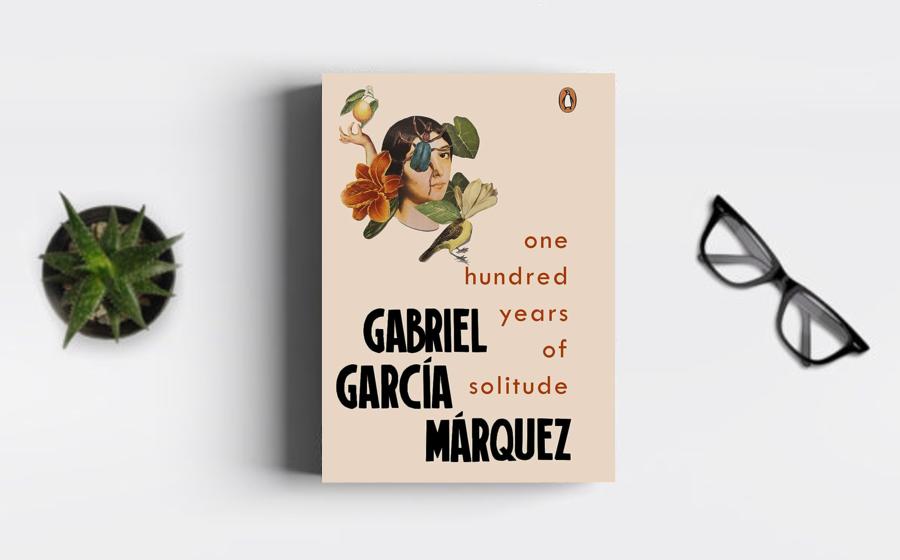"One Hundred Years of Solitude" by Gabriel Garcia Marquez stands as a magnum opus in the realm of magical
realism, a literary masterpiece that transcends
conventional storytelling. Venturing into the mythical town of Macondo is
akin to navigating a labyrinth of time, where the
Buendia family's epic saga unfolds across generations.
Garcia Marquez's narrative alchemy, blending the
ordinary with the extraordinary, propels "One Hundred
Years of Solitude" into the echelons of the Top 10 Books
of all time. It is not merely a novel; it is a symphony
of words that echoes through the corridors of literary
history, shaping the landscape of modern literature.
Gabriel Garcia Marquez, a maestro of magical
realism, elevates "One Hundred Years of Solitude" beyond
the constraints of traditional narrative forms. The
novel, born from Garcia Marquez's vivid imagination and
mastery of language, introduces readers to a world where
the magical and the mundane coexist seamlessly. I am fascinated by Garcia Marquez's ability to dissolve the boundaries between
reality and fantasy, inviting readers into a realm where
the extraordinary is woven into the fabric of everyday
life.
The lush landscapes of Macondo, with its
yellow butterflies and gypsy prophecies, become a canvas
upon which Garcia Marquez paints a portrait of a town
suspended in a liminal space between the tangible and
the fantastical. The author's prose is a river of words
that meander through the contours of time, carrying the
reader on a lyrical journey that transcends the
limitations of linear storytelling. Garcia Marquez's
narrative prowess transforms "One Hundred Years of
Solitude" into a literary marvel, a testament to the
boundless possibilities of storytelling when liberated
from the shackles of convention.
At the heart of
"One Hundred Years of Solitude" is the Buendia family
- a
lineage marked by passion, tragedy, and a cyclical
pattern of repetition and reinvention. Garcia Marquez
weaves a tapestry of time that spans seven generations,
exploring the intricacies of familial bonds, individual
destinies, and the inescapable echoes of history. I am captivated by the novel's
nonlinear narrative, where time is not a linear
progression but a fluid continuum that folds upon
itself, creating a mosaic of interconnected moments.
The characters within the Buendia family are not
static entities; they are dynamic embodiments of the
human experience. From the patriarch Jose Arcadio Buendia, driven by a relentless pursuit of knowledge and
alchemy, to the enigmatic Remedios the Beauty, who
ascends into the sky, each family member contributes to
the novel's rich tapestry. Garcia Marquez's exploration
of the cyclical nature of time adds a layer of
complexity to the narrative, prompting readers to
reflect on the interplay between individual choices and
the inexorable patterns of destiny.
Garcia Marquez's use of magical realism serves as a narrative
device that transcends the conventions of realism and
allows for a more profound exploration of the human
psyche. The fantastical elements, such as flying
carpets, levitating priests, and a rain of yellow
flowers, are not mere whimsical embellishments; they are
metaphors that unveil the hidden truths of the
characters' inner worlds.
I appreciate how Garcia Marquez employs magical realism
to peel back the layers of reality, revealing the
dreams, desires, and fears that lie beneath the surface.
The presence of the supernatural in "One Hundred
Years of Solitude" is not a departure from reality; it
is an amplification of the characters' emotional
landscapes. The magical realist elements become a mirror
that reflects the characters' internal struggles,
aspirations, and conflicts. Garcia Marquez's narrative alchemy transforms the ordinary into
the extraordinary, inviting readers to embrace a
narrative mode where the mystical and the mundane
coalesce to illuminate the complexities of the human
condition.
Romantic and passionate love courses
through the veins of Macondo like a mystical elixir,
influencing the destinies of the Buendia family across
generations. Garcia Marquez portrays love not as a
fleeting emotion but as a potent force that shapes the
characters' fates. From the intense passion between Jose Arcadio Buendia and
Ursula Iguaran to the ethereal love
of Amaranta and the tragic affair of Fermina Daza and
Florentino Ariza, love becomes an arcane energy that
propels the characters into a dance of ecstasy and
heartbreak.
I am drawn to Garcia Marquez's
nuanced portrayal of love as a force that transcends the
boundaries of time and mortality. Love becomes a thread
woven into the very fabric of Macondo, connecting the
characters across generations and echoing through the
corridors of the narrative. The exploration of love as a
transformative and enduring power adds depth to "One
Hundred Years of Solitude," elevating it beyond a mere
familial chronicle to a meditation on the universal
themes of longing, passion, and the eternal dance of the
heart.
Macondo, with its political upheavals,
revolutions, and the rise and fall of leaders, serves as
a microcosm reflecting the tumultuous history of Latin
America. Garcia Marquez infuses political allegory into
the novel, using the fictional town as a canvas to
depict the broader socio-political landscape. The
arrival of the banana company, the conflicts between
liberals and conservatives, and the various coups and
revolutions become symbolic representations of
historical events that shaped the region.
I
appreciate Garcia Marquez's ability to seamlessly
integrate political allegory into the narrative without
compromising its lyrical beauty. Macondo becomes a
reflection of the cyclical nature of political turmoil,
where ideals are betrayed, revolutions are co-opted, and
the pursuit of power becomes a self-perpetuating cycle.
The novel's political dimensions add layers of
complexity, transforming "One Hundred Years of Solitude"
into a mirror that reflects the socio-political
intricacies of an entire continent.
Garcia Marquez skillfully navigates the theme of colonialism,
weaving it into the fabric of Macondo's history. The
ghosts of the past, embodied by the gypsies, the
Melquiades, and the memories of pre-colonial indigenous
cultures, haunt the narrative. The encroachment of
foreign powers, the exploitation of resources, and the
erasure of indigenous cultures become recurring motifs
that echo the broader colonial history of Latin America.
I find Garcia Marquez's exploration of colonialism
to be a poignant commentary on the enduring scars left
by the forces of imperialism. The ghosts of the past
linger in Macondo, challenging the characters to
confront the complexities of cultural identity and the
indelible marks left by the collision of civilizations.
The novel becomes a narrative mirror reflecting the
collective memory of a continent grappling with the
legacies of colonization.
Garcia Marquez employs
rich symbolism and archetypal imagery, infusing "One
Hundred Years of Solitude" with a language reminiscent
of dreams and myths. The yellow butterflies, the
repeating motifs of mirrors and mirrors within mirrors,
and the recurring themes of solitude and circular time
become symbols that resonate on multiple levels. I am enthralled by Garcia Marquez's use of symbolism as a means of transcending
the limitations of language and delving into the
subconscious realms of the human psyche.
The
novel's archetypal elements contribute to its timeless
appeal, inviting readers to engage with the narrative on
a symbolic and universal level. The symbolism becomes a
language of the collective unconscious, transcending
cultural and linguistic boundaries. Garcia Marquez's use of
archetypes elevates "One Hundred Years of Solitude" to a
work of literature that communicates not just through
words but through the shared reservoir of human dreams,
fears, and aspirations.
Garcia Marquez disrupts the
conventional linear flow of time, creating a temporal
dislocation that mirrors the fragmented nature of
memory. The novel's non-linear structure, where events
repeat and characters experience deja vu, becomes a
mosaic of memory where the past, present, and future
coexist. I am intrigued
by Garcia Marquez's deconstruction of time, inviting
readers to navigate a narrative landscape where the
boundaries between memory and reality blur.
The
temporal dislocation adds an element of introspection to
the novel, prompting readers to reflect on the nature of
memory and its impact on individual and collective
identities. Garcia Marquez's innovative approach to
temporality transforms "One Hundred Years of Solitude"
into a mirror that reflects the kaleidoscopic nature of
human recollection, where moments of joy, sorrow, and
revelation coalesce into a timeless tapestry.
The
theme of solitude reverberates throughout the novel,
transcending its literal meaning to become a metaphor
for the human condition. Garcia Marquez explores the
various dimensions of solitude - physical, emotional,
existential - through the lives of the Buendia family.
From Jose Arcadio Buendia's solitary pursuits in alchemy
to the existential solitude of Aureliano Buendia, the
characters grapple with the elusive quest for connection
and meaning in the vast expanse of existence.
I
am moved by Garcia Marquez's poignant exploration of
solitude as a universal theme that resonates with
readers across cultures and epochs. The characters'
struggles with isolation, the yearning for connection,
and the elusive pursuit of understanding become a
reflection of the human journey. The theme of solitude
elevates "One Hundred Years of Solitude" beyond a mere
family chronicle to a meditation on the fundamental
human longing for communion and the enduring echoes of
isolation that reverberate through the corridors of
time.
"One Hundred Years of Solitude" stands as a
beacon, guiding readers through a labyrinth of
emotions, memories, and existential reflections. It
is not merely a novel; it is a testament to the
enduring power of storytelling to illuminate the
complexities of the human journey. Garcia Marquez's
masterpiece continues to cast its spell across
generations, inviting readers to lose themselves in
the labyrinthine corridors of Macondo and emerge,
transformed, into the luminous realm of literary
enchantment.






